Sheng-Yu Peng
Transfer Learning for Keypoint Detection in Low-Resolution Thermal TUG Test Images
Jan 30, 2025Abstract:This study presents a novel approach to human keypoint detection in low-resolution thermal images using transfer learning techniques. We introduce the first application of the Timed Up and Go (TUG) test in thermal image computer vision, establishing a new paradigm for mobility assessment. Our method leverages a MobileNetV3-Small encoder and a ViTPose decoder, trained using a composite loss function that balances latent representation alignment and heatmap accuracy. The model was evaluated using the Object Keypoint Similarity (OKS) metric from the COCO Keypoint Detection Challenge. The proposed model achieves better performance with AP, AP50, and AP75 scores of 0.861, 0.942, and 0.887 respectively, outperforming traditional supervised learning approaches like Mask R-CNN and ViTPose-Base. Moreover, our model demonstrates superior computational efficiency in terms of parameter count and FLOPS. This research lays a solid foundation for future clinical applications of thermal imaging in mobility assessment and rehabilitation monitoring.
TrustEMG-Net: Using Representation-Masking Transformer with U-Net for Surface Electromyography Enhancement
Oct 04, 2024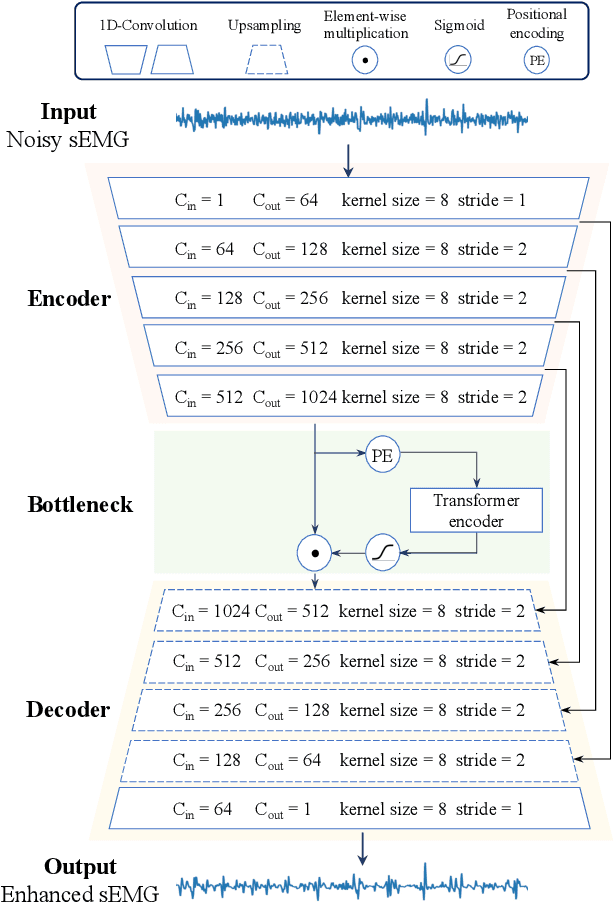
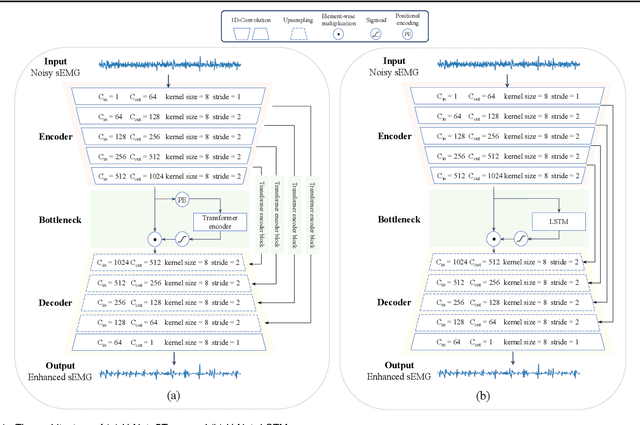
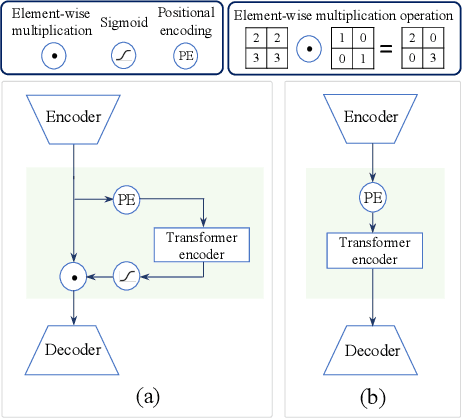
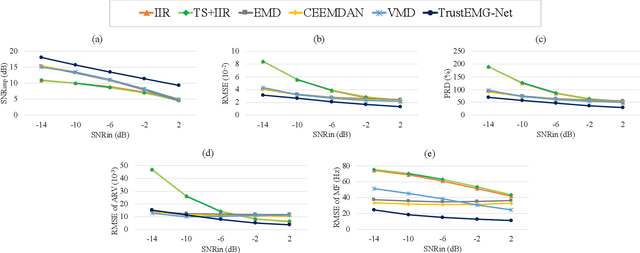
Abstract:Surface electromyography (sEMG) is a widely employed bio-signal that captures human muscle activity via electrodes placed on the skin. Several studies have proposed methods to remove sEMG contaminants, as non-invasive measurements render sEMG susceptible to various contaminants. However, these approaches often rely on heuristic-based optimization and are sensitive to the contaminant type. A more potent, robust, and generalized sEMG denoising approach should be developed for various healthcare and human-computer interaction applications. This paper proposes a novel neural network (NN)-based sEMG denoising method called TrustEMG-Net. It leverages the potent nonlinear mapping capability and data-driven nature of NNs. TrustEMG-Net adopts a denoising autoencoder structure by combining U-Net with a Transformer encoder using a representation-masking approach. The proposed approach is evaluated using the Ninapro sEMG database with five common contamination types and signal-to-noise ratio (SNR) conditions. Compared with existing sEMG denoising methods, TrustEMG-Net achieves exceptional performance across the five evaluation metrics, exhibiting a minimum improvement of 20%. Its superiority is consistent under various conditions, including SNRs ranging from -14 to 2 dB and five contaminant types. An ablation study further proves that the design of TrustEMG-Net contributes to its optimality, providing high-quality sEMG and serving as an effective, robust, and generalized denoising solution for sEMG applications.
SDEMG: Score-based Diffusion Model for Surface Electromyographic Signal Denoising
Feb 06, 2024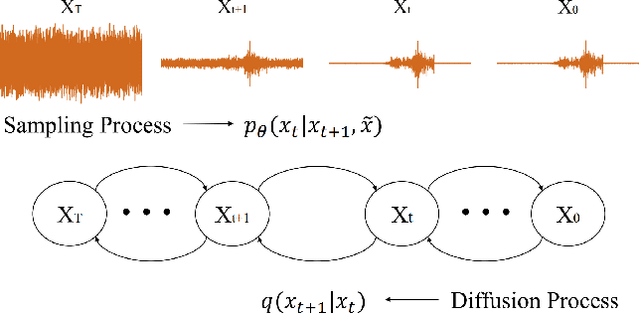

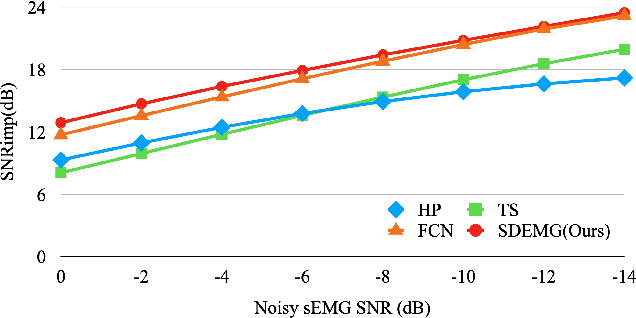
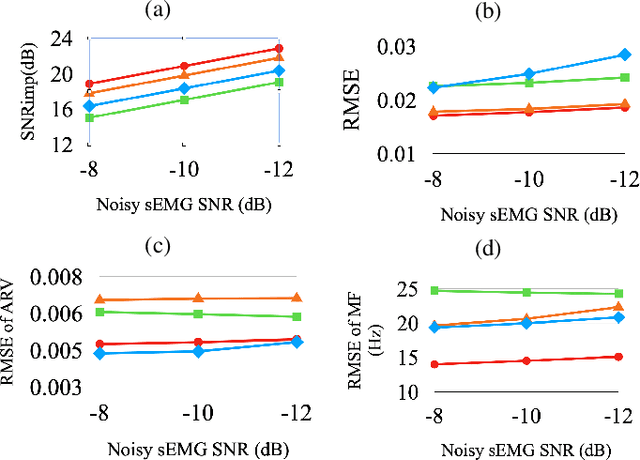
Abstract:Surface electromyography (sEMG) recordings can be influenced by electrocardiogram (ECG) signals when the muscle being monitored is close to the heart. Several existing methods use signal-processing-based approaches, such as high-pass filter and template subtraction, while some derive mapping functions to restore clean sEMG signals from noisy sEMG (sEMG with ECG interference). Recently, the score-based diffusion model, a renowned generative model, has been introduced to generate high-quality and accurate samples with noisy input data. In this study, we proposed a novel approach, termed SDEMG, as a score-based diffusion model for sEMG signal denoising. To evaluate the proposed SDEMG approach, we conduct experiments to reduce noise in sEMG signals, employing data from an openly accessible source, the Non-Invasive Adaptive Prosthetics database, along with ECG signals from the MIT-BIH Normal Sinus Rhythm Database. The experiment result indicates that SDEMG outperformed comparative methods and produced high-quality sEMG samples. The source code of SDEMG the framework is available at: https://github.com/tonyliu0910/SDEMG
ECG Artifact Removal from Single-Channel Surface EMG Using Fully Convolutional Networks
Oct 24, 2022Abstract:Electrocardiogram (ECG) artifact contamination often occurs in surface electromyography (sEMG) applications when the measured muscles are in proximity to the heart. Previous studies have developed and proposed various methods, such as high-pass filtering, template subtraction and so forth. However, these methods remain limited by the requirement of reference signals and distortion of original sEMG. This study proposed a novel denoising method to eliminate ECG artifacts from the single-channel sEMG signals using fully convolutional networks (FCN). The proposed method adopts a denoise autoencoder structure and powerful nonlinear mapping capability of neural networks for sEMG denoising. We compared the proposed approach with conventional approaches, including high-pass filters and template subtraction, on open datasets called the Non-Invasive Adaptive Prosthetics database and MIT-BIH normal sinus rhythm database. The experimental results demonstrate that the FCN outperforms conventional methods in sEMG reconstruction quality under a wide range of signal-to-noise ratio inputs.
 Add to Chrome
Add to Chrome Add to Firefox
Add to Firefox Add to Edge
Add to Edge